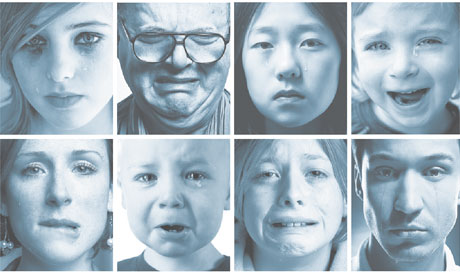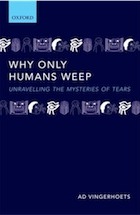Why do humans cry? A new reading of the old sob story
We all cry, but what biological function does it serve, and why are humans the only species to shed tears of sorrow and joy?

‘Tears are less important when you are alone because there is no one to witness them’
When it came to solving the riddle of the peacock's tail, Charles Darwin's powers of evolutionary deduction were second to none – the more extravagant their feathered displays, he reasoned, the greater their chances of attracting a peahen. But when he tried to account for the human propensity to weep, Darwin found himself at a loss. "We must look at weeping as an incidental result, as purposeless as the secretion of tears from a blow outside the eye," he wrote in 1872.
In this Darwin was almost certainly wrong. In recent decades, scientists have offered several accounts of how the capacity for tears may have given early hominids an adaptive advantage. These range from the aquatic ape theory, according to which tears were an adaptation to saltwater living, to the notion that by blurring our vision tears may serve as a "white flag" to potential aggressors – a signal that the crier is incapable of harm. Then there are the straightforward biological theories, such as the claim that tears evolved to keep the eye moist and free of harmful bacteria.
But perhaps the theory enjoying the widest currency at the moment is the notion that tears are a form of social signalling that evolved from mammalian distress calls – a clear visual signal in other words that someone is in pain or danger and needs help.
"Tears are highly symbolic," says Ad Vingerhoets, a Dutch psychologist who has spent 20 years studying why and when we weep. "They signal helplessness, especially during childhood when humans are at their most vulnerable."
Vingerhoets is not the only thinker to point to the social significance of tears. The psychiatrist John Bowlby long ago highlighted the role of crying in engendering attachment between mother and child, while the British neurologist Michael Trimble recently linked crying to the human capacity for empathy – hence our propensity to weep during inspiring music.
However, in his new book, Why Only Humans Weep, Vingerhoets argues that none of these explanations is sufficient. Although crying has been documented in apes, elephants and even camels, it seems that only humans produce emotional tears, and it is only in humans that crying behaviours persist into adulthood. The challenge is to explain why this should be so, given that tears also run the risk of signalling our presence to predators.
Vingerhoets's explanation is novel: although in certain situations weeping can be risky, he suggests it is far less risky than screaming or emitting some other loud acoustic signal. This is particularly true in the case of interactions at close quarters, such as occur during the extended period of human childhood, when a tear may be all that is required to alert a mother to her baby's suffering.
"When other animals grow old, most no longer emit distress signals, presumably because it is too dangerous, says Vingerhoets. "By contrast, in humans there is a shift from the acoustic signal, emitted in all directions, toward the visual signal of tears, which especially fit closer, more intimate interactions.'
In support of his theory Vingerhoets points to the enlarged visual cortex in humans and old-world primates – a structure, he argues, that most probably evolved to read the nuances of facial musculature and other strong visual clues, such as tears and blushing. In addition, crying is an emotional expression that signals appeasement and supplication in adults – something that he argues would have been advantageous in early human communities as a means of promoting greater mutual trust and social connectedness.
So far, so fine. But of course crying is not only associated with the human need for attachment. Tears can also be moral, signifying our sympathy with an injustice. Moreover, as the cultural historian Thomas Dixon points out, tears are sometimes associated with joy and ecstasy rather than grief and sorrow – hence the mass emotional displays during the London Olympics.
The trouble with tears is that they are always "thick" with description. "Tears are intellectual things," argues Dixon. "They are produced both by thoughts and the lachrymal glands. In each age, different texts collaborate with different bodies to produce tears with different meanings."
To be fair, Vingerhoets is very much alive to the way that crying is both a product of involuntarily neurophysiological processes and cognition. Sometimes, as when we weep while chopping an onion, tears may signify nothing at all; at other times they may be an expression of profound grief or sadness.
The trouble is that quite often – as when people cry when driving alone, a common phenomenon according to Vingerhoets – our tears catch us unawares, prompting us to become upset where perhaps no upset is called for. In such cases, it seems, tears are mother to the emotion rather than the other way round.
More so than any other form of emotional expression, tears are also subject to shifting cultural and historical readings, symbolising piety and sensitivity in one age and hysteria and weakness in another.
Whatever the precipitant, however, there is a widespread belief that crying is cathartic. However, even this may be a construct, says Vingerhoets. Although people frequently report feeling better after watching a Hollywood "tearjerker" with a friend, when asked to watch a similar movie in a laboratory setting they usually report no improvement in mood at all. For Vingerhoets this is further evidence of the social function of crying. "Tears are less important when you are alone because there is no one to witness them," he says.
But while we may prefer to cry in the presence of friends and family, this need not be the case. As the pious tears shed by monks in contemplation of God attest, we can also shed tears for distant and highly symbolic attachment figures. What counts, it seems, is the feeling that our helplessness is being acknowledged.


No comments:
Post a Comment